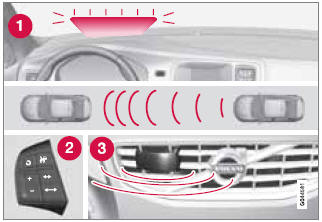Function


Function overview
1 Warning light, braking by driver required
2 Controls in steering wheel
3 Radar sensor in front grille
Adaptive Cruise Control consists of:
Х A cruise control system to maintain a set
speed
Х A system to maintain a set distance to the
vehicle ahead, which is expressed as a
time interval. For example, you can choose
to remain approximately 2 seconds behind
the vehicle ahead. The actual distance
required to maintain a 2-second interval
will vary according the speed of the vehicles.
WARNING
Х Adaptive Cruise Control is not a collision
avoidance system. The driver is
always responsible for applying the
brakes if the system does not detect
another vehicle.
Х Adaptive Cruise Control does not react
to people or animals, or small vehicles
such as bicycles and motorcycles. It
also does not react to slow moving,
parked or approaching vehicles, or stationary
objects.
Х Do not use Adaptive Cruise Control in
demanding driving conditions such as
city driving or other heavy traffic situations,
in slippery conditions, when there
is a great deal of water or slush on the
road, during heavy rain or snow, in poor
visibility, on winding roads or on highway
on- or off-ramps.
The distance to the vehicle ahead (in the same lane) is monitored by a radar sensor. Your vehicle's speed is regulated by accelerating and braking. The brakes may emit a sound when they are being modulated by the adaptive cruise control system. This is normal.
WARNING
The brake pedal moves when the adaptive
cruise control system modulates the
brakes. Do not rest your foot under the
brake pedal.
The ACC system is designed to smoothly regulate speed. However, the driver must apply the brakes in situations that require immediate braking. This applies when there are great differences in speed between vehicles, or if the vehicle ahead brakes suddenly.
WARNING
Due to limitations in the radar sensor, braking
may occur unexpectedly or not at all,
see page 159.
Adaptive Cruise Control can be put in active mode at any permitted speed. However, if the vehicle's speed falls below 18 mph (30 km/h) or if engine speed (rpm) becomes too low, ACC disengages (goes into standby mode) and will no longer modulate the brakes2. The driver will then have to maintain a safe distance to the vehicle ahead.
WARNING
When Adaptive Cruise Control is in standby
mode or is switched off completely, the
brakes will not be modulated automatically.
The driver must assume full control over the vehicle.
See also:
Installing the steel cargo grid
For information about the necessary tools and
procedures for installing/removing the steel
cargo grid, please refer to the assembly
instructions that were included when the grid
was purchased. ...
Opening the trunk manually
The trunk is held closed by an electronic locking mechanism. To open:
1. Press lightly on the rubberized plate under the handle to release the lock.
2. Lift the handle to open the trunk lid.
CA ...
Environment
Volvo and the environment
Volvo is committed to the well being of its customers.
As a natural part of this commitment,
we care about the environment in which we all
live. Caring for the environm ...
